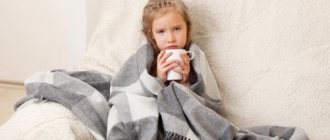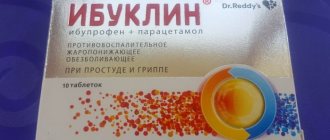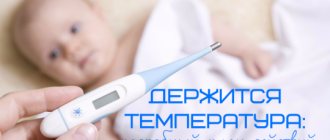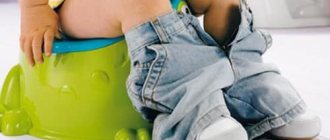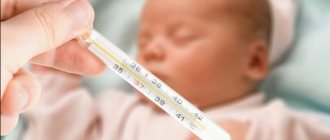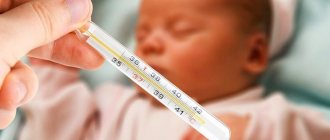What temperature should be reduced by wiping with water?
An increase in body temperature during illness indicates that the body is trying to cope with the disease on its own by producing antibodies and interferon.
Therefore, if the temperature does not exceed 38-38.5 °C, you should not lower the temperature - this may negatively affect the functioning of the immune system (it will reduce the ability to resist diseases).
You need to take certain measures in the following cases:
- An increase in body temperature above 38.5 °C.
- Difficulty breathing in a child.
- Unusual behavior (for example, the child is very capricious, cries, has chills, etc.).
In such situations, it is necessary to increase the heat transfer of the body, because the child does not need to be wrapped in warm things - he should be as undressed as possible.
Rubbing helps to quickly increase heat transfer from the skin, but the temperature inside the body may remain high. Therefore, if the child’s well-being worsens, effective antipyretics should be used, and it is better to seek medical help.
Fighting fever
Do I need to immediately bring down my baby’s fever? Doctors do not advise doing this, since it is at high temperatures that immune processes are activated. The body begins to actively produce interferon, which strengthens its defenses. You should also know that at the so-called subfebrile temperature (37 – 38) most microorganisms die. Consequently, taking antipyretics will simply disrupt the body’s self-healing process.
If the thermometer shows 38.5 or 39, in this case the child needs help. But don’t rush to give medicine - you can simply wipe the baby with water. Drying children is an ancient way to combat fever. It was used when there was no medicine at hand. However, you need to rub the baby correctly - it is important not to harm or cause chills.
In what cases does the fever in children come down:
- in children up to three months - at around 38 degrees;
- with difficulty breathing and changes in skin color;
- in case of inappropriate behavior of the child;
- with a rash on the body, muscle pain;
- when a child cries for a long time.
In extreme heat, it is better to give fever medicine than to rub the child with liquids. It is also unacceptable to cool the body during chills, when the palms and feet are cold: first you should warm up the baby.
When should physical measures be used to cool a child with a fever? They are used at the very beginning of the onset of fever and in the interval between taking antipyretics.
Contraindications for carrying out
Wiping with water when a child has a fever is a safe method, but in some cases it may be contraindicated.
The method will not apply when:
- Convulsions in a child.
- Cold hands and feet (the rest of the body remains hot).
- The presence of damage to the skin (scratches, abrasions, open wounds).
- Severe muscle pain.
- Temperatures above 39.5 °C (it is critical and requires the use of more effective measures to bring it down).
- Pallor of the skin.
- During attacks of nausea and vomiting.
- The child’s tendency to allergic reactions (when using herbal infusions, vinegar or vodka).
- At an early age - up to 3 years.
In any case, you should consult your pediatrician before using this procedure.
Aqueous solutions for wiping a child, proportions
A child at a high temperature is wiped not only with plain water - it is popular to add vinegar, vodka, or use herbal infusions and soda solution. Each of these options has its own application and preparation characteristics.
Plain water
For wiping, you must use water at a temperature of 34-36 °C. If you take a hot liquid, you may not get the desired result, and using cold water can cause chills, trembling and even convulsions. This procedure can cause vasoconstriction, which in turn increases the risk of internal overheating of the body.
With vinegar
Bite rubbing is one of the oldest and most effective ways to quickly reduce the temperature and remove signs of fever.
For these purposes, it is recommended to use an apple bite of natural origin - it does not have an aggressive effect on the body in comparison with a table bite. Additionally, apple cider vinegar has a beneficial effect on the functioning of the nervous system, providing a calming effect.
During the procedure you must:
- Use the bite only in diluted form - the ratio with water should be 1:1. If table vinegar is used, then for 500 ml of water you need to take 1 tbsp. l. vinegar
- The temperature of the solution prepared for wiping should be within 37 °C.
- After drying the child, cover with a light cotton cloth.
- A napkin soaked in a vinegar solution should be placed on the child’s forehead. It needs to be constantly changed.
The use of vinegar rubbing helps reduce the temperature by 1.5 °C within 1 hour.
With vodka
Vodka for rubbing should be used with caution and used to relieve fever in children over 7 years of age. You can only use vodka diluted with water to avoid irritation, itching, and redness. To prepare the solution, you need to mix warm water and vodka in equal proportions.
The wiping procedure consists of the following steps:
- Moisten a cloth in the prepared solution.
- Rubbing should be done with light and massaging movements. The heart, groin and abdomen areas should be avoided during this process.
- After completing the procedure, the child should be blown with warm air from a hairdryer for 1 minute.
- After this, the child should be placed in bed and a compress of cool water should be placed on the forehead, changing it periodically.
It is important to monitor the child’s temperature every half hour - if it does not rise, the rubdown can be repeated.
With soda
Wiping with a soda solution is carried out by analogy with a water solution.
To prepare the product you need:
- 0.5 tsp. soda pour 200 ml of hot water.
- Cool the solution to 30-32 °C.
The prepared solution can be used for wiping, as well as making compresses on the armpits and forehead. Traditional healers recommend taking this solution orally to relieve intoxication. It should not be used for drinking by children under 7 years of age.
With herbs
Using a decoction of medicinal herbs is one of the safest ways to reduce fever. Properly selected herbs provide caring care to the baby's skin, soothing it and relieving irritation. It is important to use only those plants to which the child is not allergic.
Rubbing with water and chamomile decoction at a temperature is one of the safest methods
The herbal decoction is prepared as follows:
- The herb or a complex of herbs (a total of 2 tablespoons of raw materials will be required) must be poured into 1 liter of boiling water.
- The resulting mixture should be infused for 40 minutes.
- After this time, the finished broth must be strained.
- You should wet the cloth in the prepared broth and wrap it around the child, leaving the arms and legs open.
- The child must be covered with a light blanket on top and left in this state for half an hour.
- After this, the child should be washed with warm water and dried with a towel.
How to properly dilute vinegar for wiping a child with a fever?
To obtain a safe and effective composition for rubbing, it is necessary to dilute the vinegar correctly. Otherwise, the child may get burned, since his skin is very delicate. It is important to maintain certain proportions.
To prepare the solution, it is recommended to use rice, apple or wine vinegar. These types of vinegar are more gentle. You can also use regular one with a concentration of 9% or 6%. Take 1 tbsp for half a liter of water. vinegar.
If 6% vinegar is used for wiping, then it is diluted with water in a ratio of 1:1, and for 9% the proportion is 1:2 or 1:2. The solution must be mixed thoroughly and used immediately. The water temperature should be within 37-38 degrees; if it has cooled down, then you need to prepare a new composition. Do not use cold liquid for rubbing.
Preparing to wipe your baby with water
Children must be prepared before wiping. To do this, you need to remove all their clothes and lay them in a horizontal position. To prevent the bed linen from getting wet, you can put an oilcloth under the patient and cover it on top with a sheet or towel, which must be removed and dried after wiping.
If the child is capricious, he should be put to rest - forcibly carrying out the procedure will only aggravate the situation and may cause an even greater rise in temperature.
It is also necessary to create suitable conditions:
- Air temperature. It should be comfortable for the patient - within 18-22 °C.
- Access to fresh air - the room should be ventilated regularly.
- Napkin – it should be soft and made of natural fabrics (linen, cotton).
How to properly dry a child?
Rubbing with water at a child’s temperature must be done correctly - this will help to quickly achieve the desired result.
This process consists of several stages:
- An undressed child should be placed on his back.
- You need to moisten a napkin in the prepared water or wiping solution and squeeze it out a little.
- With a moistened napkin, you need to start wiping your hands with light movements, moving from the palms and to the shoulder (particular attention should be paid to the armpit area and the bend at the elbow).
- Next, you should wipe your legs, starting from the feet and gradually moving up to the hips.
- Then you need to wipe your chest and back.
- After the procedure is completed, it is recommended to leave the child uncovered. If it is too small or the room temperature is below +18 °C, the child should be covered with a light sheet or blanket.
If the temperature does not begin to decrease, then after 15 minutes the procedure must be repeated. During wiping, the napkin must be constantly moistened and the temperature of the water monitored - if it has cooled down, you need to add a little hot liquid.
High temperature wiping methods
For rubbing to lower the temperature, vinegar, vodka, water and herbal infusions can be used. The simplest and safest method of wiping is using warm water. The baby's hands and torso must be wiped with water at a temperature above room temperature. After the procedure, the child should be covered with a thin sheet.
The alcohol rubdown method is quite dangerous for a fragile body. Vodka, when rubbed through the skin, enters the bloodstream, and as a result, the baby may experience poisoning with alcohol-containing substances. This procedure is especially dangerous for young children. Superficial rubbing with an alcohol-containing solution can increase core body temperature.
Most often, wiping with a vinegar solution is used to reduce body temperature. In this case, it is important to dilute the vinegar correctly, otherwise a number of negative reactions may occur.
There are several methods of wiping: general and local. With the general method, the child should stand in a bathtub or basin with warm water, he is wrapped in a damp sheet.
The second option for the general procedure is wiping the entire body with a cloth soaked in water or solution. First, the arms, armpits, back, back of the legs are treated, and only then the stomach and chest. Finally, the feet are wiped.
During local wiping, the limbs are treated. They should be wiped from the periphery to the center. The chest and stomach are also rubbed, and the back is rubbed along the spine. When choosing a wiping method, you should pay attention not only to its effectiveness, but also to its safety.
Consequences and complications after the procedure
Wiping with water when a child has a fever, despite being relatively safe, can lead to undesirable consequences.
The table shows the possible consequences after the procedure:
| What can happen? | What could be the consequences? |
| A rapid decrease in skin surface temperature (only the temperature of the skin and muscle tissue decreases, but not the internal organs). | There is a violation of heat transfer. As a result, vasospasm occurs and the risk of heat stroke (overheating of internal organs) increases. |
| A sharp decrease in body temperature (by 2° or more per hour when the norm is 1-1.5°). | The child may develop collapse (impaired cerebral blood flow, oxygen starvation of the brain). |
These complications pose a real threat to the child’s life.
Also, the use of alcohol and vinegar solutions can lead to:
- Development of respiratory spasms.
- Allergic reactions.
- Skin irritation.
- General intoxication of the body (acetic acid and alcohol can penetrate the skin into the body, and their vapors enter the respiratory system).
In the future, the above conditions can cause more serious diseases of the kidneys, liver, respiratory system, and also significantly reduce immunity.
How to quickly reduce a child's fever using folk remedies
Such methods are considered completely safe, but this is not always the case. Improper use of folk remedies can lead to serious consequences. In addition, despite their naturalness, folk remedies have their limitations in use.
Before carrying out procedures at home, consult your pediatrician. This is especially important when it comes to not only the health, but also the life of the child.
Among the folk remedies for antipyretic action, there are several that are most effective.
Rubdown
In this case, wiping is best done with simple purified water. It is also possible to add a vinegar solution to the water, which helps relieve fever.
It is necessary to wet a small piece of gauze with the solution, with which the wiping procedure will be carried out. It is recommended to wipe the entire body, avoiding the heart area (when using a vinegar solution). But special attention should be paid to the area of the armpits, temples and neck.
Remember that using rubbing alcohol is prohibited if your body temperature is elevated. Such a “procedure” can only aggravate the situation, significantly worsening the child’s condition.
Cabbage leaf compress
Although this procedure seems safe, it should not be abused either. If one-time use of cabbage leaves does not bring any results, then you should try other methods.
Take a few white cabbage leaves and place them in boiling water for a couple of seconds. Next, you should beat the steamed leaves using a special hammer in order to release the juice.
We apply the leaves to the baby's body, again avoiding the heart area.
Enema
If it is not possible to reduce the temperature by external influence on the body, then you will have to resort to internal temperature reduction.
To do this, you need to fill a medical bulb with water at room temperature and insert it into the baby’s rectum.
Never fill the enema with too cold or hot water, as this may worsen the child’s condition.
Barley broth
First, boil a glass of pearl barley in purified water for five minutes. After the time has passed, strain the broth, passing it through a sieve.
Dissolve a teaspoon of honey in the resulting liquid (to sweeten the pill) and give the child the decoction to drink.
Tea with raspberries
Raspberries contain a large amount of vitamin C, which helps strengthen the immune system. This will help speed up the process of fighting the disease, and therefore reduce the temperature.
But you should also be careful when using such a product, since exceeding the dosage of raspberry jam can lead to the development of an allergic reaction.
Therefore, you can dissolve just one teaspoon of jam in a cup of warm tea. Please note that the drink should only be warm, but not hot.
What to do if water rubdowns do not help?
If water rubdowns do not help reduce the child’s temperature within one hour, it is necessary to use antipyretic drugs.
If the body temperature in children is above 39.5-40 ° C, it is necessary to call an ambulance - an increase in temperature to 41 ° C and above is life-threatening and requires immediate medical intervention. Therefore, before using this method of reducing body temperature, you should definitely consult with your pediatrician.
How to reduce a child’s temperature with medications - tablets, syrups
Many mothers try to avoid using medications to reduce fever, but sometimes it is simply necessary.
How many days does a fever last for a sore throat?
The reasons for an increase in body temperature can be completely different, and therefore it is not always possible to eliminate the fever using folk remedies alone.
Children cannot always swallow a whole tablet, so most antipyretics are also available in the form of syrups. Their peculiarity is that the drug begins to act within 20 minutes after administration.
Also, an ideal alternative to tablets are suppositories, which act after 40 minutes. They are placed if the child refuses to take syrup or tablets due to nausea.
The most effective, and, importantly, safe means include two main types of antipyretic drugs.
Paracetamol
A one-time dose of this remedy reduces the temperature by a maximum of one and a half degrees, and its effect lasts for four hours.
A slight excess of the dose will not create problems, but it should still be used only under the supervision of a doctor. It is best to use syrup, as it will reduce the temperature much faster.
Paracetamol has an antipyretic and analgesic effect, but it is absolutely powerless in inflammatory processes.
It will be most effective against viruses, but it is unlikely to be able to overcome a bacterial infection. Therefore, if Paracetamol does not help you, then call a doctor immediately.
The drug has quite a lot of analogues, united by one main component:
- Panadol. Available in the form of tablets, syrup and suppositories. You can start taking the drug from three months; — Efferalgan in the form of syrup can be given to babies from one month old. It can be diluted with milk, water or juice; — Calpol in the form of a suspension is recommended for children from three months. You can drink it with water, but do not dilute it.
Ibuprofen
Unlike Paracetamol, this drug has an anti-inflammatory effect, which not only helps reduce fever, but also combats the causative agent of the disease.
It will be equally effective for both viral and bacterial infections.
Ibuprofen has several analogues, among which are:
— Nurofen in the form of a suspension can be given to children from three years old, and the dosage will depend on the age and weight of the baby. Candles can be used from three months to two years; — Ibufen (suspension) can be taken by children from one year old. The product is quite strong, so it is prescribed at particularly high temperatures.
Self-medication in this case is quite dangerous, since the child’s body is especially sensitive to medications. Therefore, it is better to contact a pediatrician who will make an accurate diagnosis and prescribe the correct treatment.

